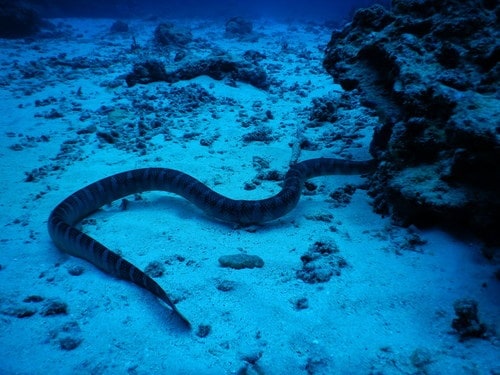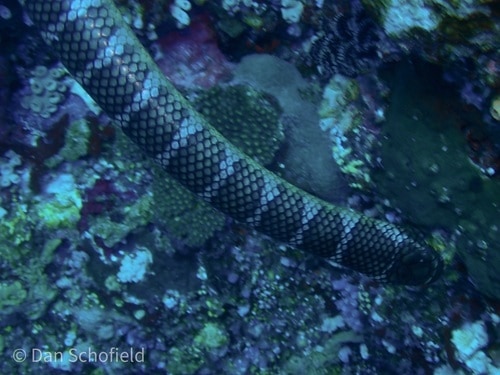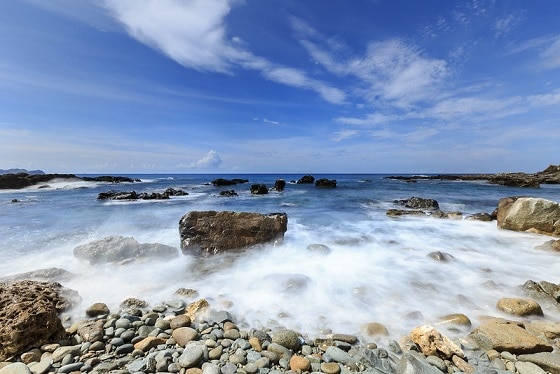| 1 | Japan and Taiwan’s sea snake |

The Australian coast is swarming with sea snakes, with over 20 different species, making it almost impossible to swim along a beach without meeting one. As you travel north, and waters grow cooler, they steadily thin out, until you meet the most northeasterly sea snake of all: the black-banded sea krait (Laticauda semifasciata).
This venomous species inhabits parts of Indonesia and the Philippines, but is most abundant in cooler waters off Taiwan and Japan. They’re a common sight in the Japanese Ryukyu islands, where traditional fishermen in their wooden boats sail past them daily. They’re even a traditional delicacy, which acts as an aphrodisiac for men and women (supposedly), and was served in the royal court of the ancient Ryukyu kingdom.
Instead of the giant 36 member Hydrophis family, black-banded sea kraits are part of the 8 member Laticauda family, along with banded sea kraits. Per drop, their venom ranks among the 30 most lethal worldwide. Its LD50 score is 0.21mg, outstripping the elegant sea snake (0.27mg) and banded sea krait (0.4mg). However, no deaths are confirmed, as they’re perfectly calm around humans. They only bite if gripped, and then it’s still not guaranteed. Many Japanese fishermen report being bitten and experiencing no symptoms as well, despite the venom having proven neurotoxic qualities.
| 2 | Hides in beachside caves |

Black-banded sea kraits are typically found in areas close to coasts, with an abundance of deep coral reefs that they can take shelter in. They can dive to depths of 80 metres, in the dark floors of the ocean, and 20-40 metres deep is standard. While they still require oxygen, they can spend 6 hours underwater without surfacing to take a breath (which normally takes 2 seconds).
Laticauda semifasciata is more sea-faring than its close relative, the banded sea krait. The latter spends 30-40% of its time on shores, digesting food or resting. However, black-banded sea kraits come to shore more rarely, mainly to reproduce. They’re particularly notorious for congregating in tidal caves en masse, the kind of hidden sandy cave a pirate would stash their treasure in. Many kraits can be found amid shallow water and rocky pools, with many males trying to woo one female.
Japanese fishermen have found cave “entrances” just 3 inches wide, which humans can’t possibly access, but the kraits can weave through effortlessly, into a hidden serpent sanctuary. The smarter fishermen wait outside these caves with their nets.
| 3 | Dangerously neurotoxic |

Laticauda semifasciata can reach large sizes, at a maximum of 1.8 metres, and have all the adaptions of fellow sea snakes. There’s a paddle-shaped tail for sweeping water out of the way, and a thinner, cylindrical body to reduce drag underwater. They have physiological adaptions that preserve oxygen, including larger lungs and red blood cell alterations.
Its venom is colourless, but viscous to touch. This species is extremely neurotoxic, like most sea snakes, and analysis from the last 50 years reveals that 95% of its lethal powers come from two toxins: erabutoxin a and erabutoxin b, which are named after the snake’s Japanese name, Erabu (itself named after an island called Okinoerabujima where they’re everywhere). A third toxin made up 5% of lethality: erabutoxin c. Then a fourth neurotoxin was found, but this was much weaker, with short-lasting symptoms.
Together, these neurotoxins act similarly to a black mamba’s neurotoxins, by binding to nicotinic acetylcholine receptors in muscle cells. They’re post-synaptic neurotoxins, meaning that they prevent brain signals from binding after being issued. The venom seems to target the lungs, as when scientists gave mice respiratory assistance, they recovered rapidly.
| 4 | Curious and inquisitive, not vicious |
Black-banded sea kraits have been reputed as calm and docile for decades, centuries, or possibly thousands of years, as that’s how long traditional Japanese fishermen have been plying their trade. But false assumptions can kill, so from 1986-1987, scientists conducted a proper study. They strapped on their wetsuits and scuba diving flippers, and swam down into the waters surrounding Orchid Island, Taiwan.
Among 48 encounters with black-banded sea kraits, none resulted in a bite. 4 snakes swam up to a distance of 5 metres then stopped. 8 swam up to closer quarters to investigate while flecking their tongues. They sometimes coiled around the scientists, usually the black flippers, but never bit. 35 snakes paid no attention at all, while 1 fled while still many metres away.
The scientists then gripped 19 black-banded sea kraits with their hands, to test their reactions when touched. This time, 5 of the 19 bit the scientists when held gently, and an extra 12 only bit when held tightly. The bites were usually slow; many kraits opened their mouths wide first, and finally sank their teeth in 30 seconds later. The default was to squirm in the scientists’ hands and try to escape. Black-banded sea kraits lack any innate aggression, and it’s perfectly safe to swim past them while on holiday.
| 5 | Sea-faring adaptions |

In a 2013 study, the 3 most common Laticauda sea kraits were compared. Banded sea kraits, being the most land-dwelling, had the highest rates of dehydration caused by salt water. But black-banded sea kraits suffered the highest rates of evaporative water loss while on land. The blue-lipped sea krait (L. laticauda) was inbetween. Black-banded sea kraits also have the most developed paddle tail and the most cylindrical body of the three.
That said, black-banded sea kraits are still more land-faring than all 36 Hydrophis members, including greater sea snakes and elegant sea snakes. These spend their entire lives on water, never flopping down onto shores and relaxing at all.
The 8 Laticauda sea kraits are more of a halfway house group, between land and sea. It’s estimated that Laticauda diverged from the Hydrophis family 12 million years ago. Then there’s the greatest sea snake of all: the yellow-bellied sea snake, which floats around on open seas hundreds of miles from land, not caring if it’s a hurricane or tidalwave, or if ships are sinking before their very eyes.
| 6 | Eats any fish it wants (except sharks) |

Along with olive sea snakes, Laticauda semifasciata has one of the most flexible sea snake diets. Scientists sailed to Orchid Island off Taiwan and dived into the waters, scoping coral environments and gathering 219 black-banded sea kraits, a hefty sample size. Another place they searched was a hidden tidal cave, which was absolutely covered with the sea kraits. This cave was submerged during high tide, but empty during low tide, except for a 1.2 metre deep pool in the centre which always remained. This cave had a humidity of near 100%, making it a perfect sea krait hangout.
The scientists also searched the intertidal zone of the island, scouting the shallow waters with flashlights at night. Orchid Island might be the global capital for black-banded sea kraits, at least according to this iNaturalist map, where it certainly has the most dots.
Back to the study, and 73 of the 219 sea kraits contained prey items, with the remainder having empty stomachs. All were fish, and these came from 16 separate families.
Youths mainly stuck to one family – the Mugilidae (mullet fish). But into adulthood, the diversity and variety exploded. Groups included tangs (Acanthuridae), and damselfishes and clownfishes of the Pomacentridae family. At 132 records, fish of the Emmelichthyidae family were the most common prey. This group includes bonnetmouths, rubyfishes and rovers.
Orchid island is home to 3 fellow sea snakes as well, each with a highly specialised diet. The banded sea krait eats eels, the blue-lipped sea krait also eats eels, while Ijima’s sea snakes are dependent on fish eggs. Black-banded sea kraits were easily the most flexible eater. The other 3 were separated into their own niches to avoid punishing competition, allowing the 4 to share the island’s waters.
| 7 | A pack-hunting snake |

In one study, scientists plunged deep into a structure called the “cathedral” 650 meters off the coast of Lombok island in Indonesia. They embarked on 32 dives from 2018 to 2022, and made 52 encounters with Laticauda semifasciata. The most bountiful day was October 5th 2019, when they found 21 kraits. All black-banded sea kraits they observed were 23-45 metres below the surface.
Many observations were made, like how after eating a fish, black-banded sea kraits would sink down and remain motionless on the floor while digesting. The freshest information was an extreme rarity in snakes – pack hunting. Cuban boas are one of the few species to do this, positioning themselves to capture bats flying out of caves, forming a wall.
On several occasions, groups of 2-6 Laticauda semifasciata were observed swimming along reefs, about 0.5 to 2 metres from the edge. They probed dark crevices with their heads, searching for fish, but there was always a clear leader doing the probing, while others followed patiently. After one probing, a follower would then take over and became the new leader, and the sea snake pack would move on.
| 8 | Lets fish into their gang |
Although they didn’t actually observe it, scientists suspected that the follower snakes were positioning themselves strategically to grab any fish that were flushed out. They could have just been leaching off the leader’s efforts, but the fact that they took turns hinted strongly at cooperation. If a whole school of fish were flushed out, there would be more than enough to feed a snake pack 2-6 strong.
In comparison, their close relative the banded sea krait (L. colubrina) was encountered many times during the study, but was always solitary.
Things then got even weirder, as gangs of up to 4 sea kraits were seen hunting with fish, specifically, the bluefin trevally and longface emperor. The snakes probed into the coral reef crevices as usual, while the fish waited around, hoping to grab smaller fish that were flushed out. Sea kraits also noticed and swam towards crevices where bluefin travelly were lurking outside, making deductions from their presence. This was less cooperation, but showed that coral reef neighbours are intelligent enough to gather information from each other.
| 9 | A popular soup ingredient |
The trade in black-banded sea kraits has been booming for decades, with traditional soup the main target. Back in the 1960s, fishermen on Japan’s Ryukyu islands would harvest 100 in a single day. A fisherman might have a hut on the beach, gather his daily snake batch with assistance from workers, then retreat to rocky beachside caves to begin the arduous preparation process.
It went like this: the black-banded sea kraits were killed by banging their heads against rocks, then thrown into a boiling vat of water. This loosened the outer skin, which the fishermen removed, along with the stomach contents. The kraits were placed on roasting racks to be heated slowly for four days, sometimes in a small cave.
When the kraits were firm enough, they were shipped to town, and roasted for an extra 7 days, until they became hard and coal black. This end product had a slightly fishy smell. The snake was cut into pieces measuring 2 inches, allowing the flesh to fall away from the bone. Then it was time to add it to soup, and enjoy the supposed health benefits including healing asthma, arthritis and low libido. This trade is still going today in reduced numbers.
| 10 | Declining but still plentiful |
Black-banded sea krait soup is called irabu-jiru in southern Japan, and is said to taste like a mixture of tuna and miso. Since 1974, numbers of Laticauda semifasciata have dropped by 90% according to IUCN, particularly in the Philippines, where the trade completely collapsed. Despite this, they’re abundant in coastal Taiwanese and Japanese waters, and aren’t close to going extinct. If they’ve dropped by that much yet still thriving, then they must have been swarming coastlines originally.
In some areas they’re expanding, possibly due to global warming increasing ocean temperatures. In 1995, they were confirmed in South Korea for the first time. A 2016 study investigated further, pinning up posters around towns in coastal South Korea, asking local fishermen to bring in any specimens of the snake illustrated, dead or alive. They complied, and soon the scientists had 12 black-banded sea kraits. Weirdly, 11 were female, and just 1 male.
Genetic analysis showed that the new colonisers had originated from Taiwan or Japan’s Ryukyu islands. There were too many for the snakes to be rogue stragglers. There was clearly a surviving colony in South Korea, setting up shop for the first time.
